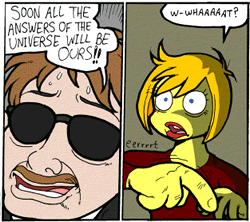Lizard is the professional patriarch of a young family in the state of New Jersey. He has a beautiful wife, a child, and some longtime friends who stay at his place. Like most professionals, Lizard wears a tie, goes to the office five days a week, and enjoys spending time at home. Lizard is also a lime-green, bug-eyed reptile who is — it should go without saying — aptly named.
Cartoony, exaggerated faces with thick, energetic lineart frame Lizard‘s look, as they do for most of author Dave Kelly’s dozens of webcomics – if you’ve checked any of them out in the past, you should have a good idea what I’m talking about. Lizard in particular features bright, inviting colors and cel-style shading. Like The Simpsons, it looks simple but not poorly-made, and it’s no small feat when you consider Kelly updates every single day.
One can’t truly explore Lizard without discussing its heritage. Dave Kelly has helmed an array of comic titles, but his most well-known has to be Living in Greytown. Long ago, way back in 2000, much of Lizard‘s cast was introduced in Greytown, a story about a town trapped in living purgatory under the control of a devil named Phil. It’s a satisfying read, and one of the first epic webcomics to wrap itself up coherently. For those who hate wading through archives however, Greytown doesn’t seem to be required reading to understand Lizard.
In fact, despite their many common bonds, don’t try to connect the two series’ plots. As an extension of Living in Greytown‘s finale, Lizard can only be seen as anticlimatic. Lizard’s storylines are generally non-offensive, involving the daily quirks of Lizard’s life and the lives of his co-workers. The supernatural rarely, if ever, creeps into the story. There are storylines, but they’re shorter and tighter, like a televised sitcom.
 As a work in and of itself, Lizard is plotted in a more pedestrian style than Living in Greytown, but also more consistently, due to Kelly’s growth as both a writer and an artist. Greytown seems an extended learning experience for Kelly, as he toggled between goofy asides and dramatic tension. These two ends of the spectrum are evident in Lizard as well, though they’re less extreme, allowing the story to flow more smoothly.
As a work in and of itself, Lizard is plotted in a more pedestrian style than Living in Greytown, but also more consistently, due to Kelly’s growth as both a writer and an artist. Greytown seems an extended learning experience for Kelly, as he toggled between goofy asides and dramatic tension. These two ends of the spectrum are evident in Lizard as well, though they’re less extreme, allowing the story to flow more smoothly.
Another facet of Lizard is its use of the anthropomorphic, or "furry", genre. You see, Lizard himself is a lizard, but his wife Zoe and many of his co-workers are human (well, technically Zoe’s only half-human, as the other half is comprised of some sort of long-necked dinosaur-creature – long story). At any rate, Lizard uses not only the conventions of furrydom, but mixes them with humans as well. However, Lizard interprets furry conventions like Gene Catlow, Saga of The Ram, and even X-Men (as well as Greytown itself) by depicting the varied anthropomorphic species as ethnic backgrounds with their own histories and prejudices. I’ve personally found this conscious "Animal Farm" approach more interesting than Disney’s animisms. Plus, to Kelly’s credit, I haven’t seen the puzzling hierarchy of animal sentience that allows Mickey the mouse to license and own Pluto the dog.
The world of Lizard is, at its heart, a wholesome one (see Purple Pussy for something more brazen). Dave Kelly himself rates it PG, so it’s something you can plop your ten-year-old in front of the screen without fear of rampant swearing or unabashed boobery. Simply put, Lizard is the story of a cute little green guy, his wife Zoe, his daughter Lizzie, his friends, and the (well-characterized) people he works with. Kelly shows readers that he can create a world that’s both simple and interesting. And if anyone deserves a simpler world, it’s Lizard. He’s been through enough, and it’s not easy being green.
Recent Comments